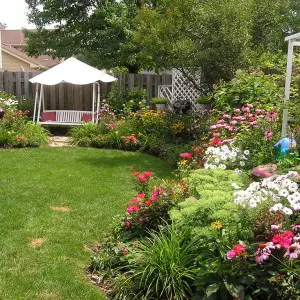We all have our own gardening style. Some people are quite content to putter in the garden. Absently plucking long shoots of crabgrass out of the petunia bed, they can escape for a while from deadlines and the real world. Others are stimulated by a competitive nature and their image of the garden as a playing field. For still others, the allure of the garden is strictly scientific. And there are gardeners for whom growing things is an excuse to spew poetry.
There is also the type I think of as the blunderers, people like myself, who love nothing more than to be caught in the grip of some grandiose gardening scheme, such as excavating a fish pond big enough to raise trout. We are, I suppose, the compulsive type of gardener. I don’t mean meticulous. A person can be compulsively neat and his or her worst offense is that the gardener in the family finds it annoying to have lost track of the trowel due to someone else’s innocent habit of putting things away. But people who are compulsive, well, compulsive don’t even think about putting things away. We’re too intent on rummaging through drawers to find the little metal bracket that would be perfect for shoring up the trellis that is hanging by a single nail as a result of its having been run into by the wheelbarrow loaded with bricks that are going to replace the cement sidewalk, when and if the cement is ever removed.
We are frequently viewed as a menace. Heedless, thoughtless, careless, and headstrong, we leave a trail of abuse and neglect. If there were a humane society for plants we would not be invited to serve on the board. Plants are particularly vulnerable around people like us. They can’t rebel or run away. They really have no choice but to submit to whatever destiny awaits them at the hands of whoever brings them home from the garden center. I’m sure that if I were a plant I would pray for someone of a careful and deliberate nature to raise me. But a plant is powerless in these matters and must rely on its innate talent for rolling with the punches.
I own a plant that rolls with the punches astonishingly well. It is a Peegee hydrangea tree. The salesperson at Frank’s, where I bought it for $19 (marked down from $79.99) assured me that there was nothing wrong with the tree. It just looked awful, due to poor treatment in transit from wherever. The branches all seemed to be grasping for some distant object–the sun, I deduced. Clearly, the tree hadn’t had enough of it. When pulled off the wooden pallet, where it had been leaning against a columnar juniper for support, little Peegee immediately fell over.
My heart went out to this frail creature. I picked it up and carried it to my car. At home, I planted it so that it groped westward since it would receive mostly eastern sun. Then I pruned the broken limbs and pulled several others toward the ground, which improved the tree’s appearance immeasurably. When I let go, however, the branches shot back up. I ran inside and fetched some string and some twigs I’d been saving for just this sort of repair work. I tied the string to the stubborn branches, pulled them into the prone position, and firmly drove the twig, with a string attached, into the ground. Altogether five branches were given this treatment. I kept thinking of a gardener who espaliers her apple trees by the bend-and-tie method. “You’re not supposed to do this, but it seems to work,” she said.
I fed and watered the tree faithfully, and soon buds were forming, an excellent sign, I thought. It must be feeling all right in spite of being shackled. I could see that the string was no longer necessary. Indeed, as the buds opened and swelled to tennis-ball size, it went slack under this unaccustomed weight. Before long the blooms were too heavy. Some of them would have to be cut off or the weakened branches would break.
On closer inspection, I saw that one of them already had. I rushed inside for more string and fashioned a splint for the broken limb, hoping to save the branch and its glorious cargo. The branch still swayed precariously back and forth. Some sort of additional incentive was needed.
Duct tape.
Frantic, I ripped a bedsheet into thin strips, then tore a length of silver-tape from the roll and began wrapping the tape around the twig splint, using the bedsheet strips to protect the bark from direct contact with the adhesive, which I assumed could clog its pores and cause the tree to suffocate. Did I mention that it had begun to drizzle? The dampened portions of the tape failed to adhere, requiring repeated applications.
The tree was by now the picture of despair; its fragile branches swathed in dirty rags and crinkled duct tape reminded me of an episode of “M*A*S*H” involving a soldier who’d stepped on a land mine. The rain only caused the tree to droop more. Fearful that other limbs would break, I grabbed a pair of lawn chairs, stripped off their cotton seats, collapsed their frames, and propped them up under the tree so that the branches hung over them.
I’d done all I could to save the limb. The next step would be amputation. Horrid thought. This happened to be the only branch that was already pointing east, away from the pack; it was a critical piece of the overall hoped-for symmetry. I can’t explain why–was it the rain?–but the damaged branch was still alive the following day. And the day after that. Six weeks later, it had mended itself and now, as I write this in early September, I can look out my kitchen window and see little Peegee standing tall and almost straight. Its flowers are turning pink. The lawn chairs are back on the lawn, fully clothed and ready for the cocktail hour.
Is there a lesson here for the blundering gardener? Several. First of all, don’t be so hard on yourself. How many “careful” gardeners would have given my Peegee a second look? How many would have gone to such ludicrous and unscientific lengths to fix it?
Lesson number two: People don’t change. Don’t ever make the mistake of gardening in order to rehabilitate yourself. The blundering personality is all-or-nothing. And as Henry Mitchell once wrote, “There are no green thumbs, only gardeners and nongardeners.” Either you were tired of gardening before the first hole was dug, or you found your emotions running rampant and all your worst (and best, if should be said) habits allowed absolute free rein. Accordingly, it makes no difference how earnestly you believe that you are employing the disciplines of horticulture to tame your own lack of discipline, or, conversely, how desperately you are banking on nature to unleash the wild demon in you. In the garden, the real you comes crashing to the fore.
Lesson number three: If you take things too far sometimes, admit it. Okay, I admit it. I often refer to the overambitious schemes I crave as “projects,” a bald-faced euphemism, of course. Replacing the washer in the bathroom faucet is a project. But the construction of the Hoover Dam was also a project. My family isn’t fooled. They know that while the faucet will go on leaking indefinitely, the Hoover Dam cannot be put off another minute. At our house, “project” is a code word for trouble.
My younger daughter used to fall into the project trap time and time again–lulled into compliance by a personality quirk that early on marked her as a “pleaser,” and by my insidious way of exploiting this weakness by referring to her fondly as “Mommy’s little helper.” But last summer she had a minor epiphany brought on by a “project” that found her outside in the garden at midnight in a terrible thunderstorm, shoving long black metal rods into plastic cylinders so that Mommy could then pound on them with a rubber mallet.
“What in God’s name were you doing out there?” my husband inquired when the two of us climbed into bed shivering a few hours before dawn. As usual, I was unwilling to go into the particulars. “Putting up an arbor” somehow didn’t sound plausible even to me. My daughter made a stab at it, and as she did she began coughing. We both developed terrible colds, which held on for the duration of the ten-day vacation that had provoked this “project” to begin with. Leaving one’s garden at the peak of summer is never easy. Especially when there is a carton in the garage with an English arbor in it, unassembled, to be sure, but plastered with practically lifesize color photos of how the arbor will look once you’ve completed the simple, step-by-step instructions.
This brings us to lesson number four: Don’t launch a major new gardening project when your plane is taking off in an hour, when there’s a steak under the broiler, when the in-laws will be here any minute, or when you’re running a bath. Time is not on your side.



